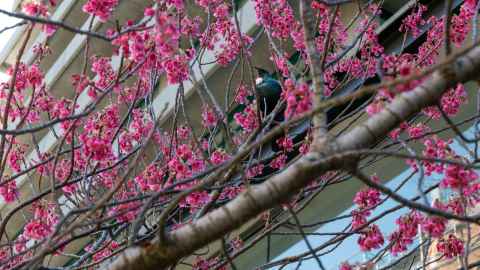Enhancing biodiversity
Learn what the University is doing to care for and enhance the biodiversity of our urban and non-urban spaces, including reserves and extensive botanic collection.

Our grounds team
The Grounds and Precinct team's kaitiakitanga practice is founded on minimising external inputs to create a sustainable biodiverse ecosystem.
A sanctuary for bees sits next to the nursery where seedlings are propagated, no pesticides or herbicides are used and, as the trees reach the end of their lifespan, there is an extensive mulching programme to reduce water use, suppress weeds and improve the soil. Any salvageable wood is turned into garden seating.
Biodiversity in campus planning
Our new Sustainable Design and Delivery Guidelines, published in 2024, emphasise the following for biodiversity:
- Establish project boundaries that are inclusive of the outdoor and non-built environment. Apply landscape and site design to all projects.
- Set clear targets and metrics (including a percentage increase of plantable area and canopy cover) for biodiversity net gains for all projects.
- Prioritise native planting, support bird corridors and sensitive species and areas.
- Design and install advanced stormwater management systems such as rain gardens and permeable pavements to reduce surface runoff.
Our urban environment
Sector 100 gardens
The university’s historic sector 100 gardens include over 400 trees and shrubs. A master survey sheet records each tree’s key attributes, including common and botanical name, height, girth, crown spread, general condition, age, protection status, location and whether there is any management work required.
Current management work practices of the gardens surrounding the collection include choosing plants that support bird life, insect life such as bees and butterflies, composting garden debris, extensive mulching, chipping all branches to place them back into the garden, controlling moisture levels and soil temperature, as well as limiting pesticides and herbicides.
University of Auckland city campus biota
In 2018, Associate Professor of Biological Sciences, Bruce Burns, set up a project with a local crowd-sourcing website to help investigate the University of Auckland's City Campus biota. The project now has over 2700 observations representing more than 1,100 species, including protozoans, fungi, plants, chromista, molluscs, insects, arachnids, reptiles, mammals, amphibians, and birds.
Native bee colony
The ngaro huruhuru, native bee colony, has been dwelling on the turf-covered earth bank at the rear of Old Government House, where the hatching of two species of bees took place in early November 2021. Their nest site is protected by punga fern logs securing the turf bank. The Three Kings Titoki, Alectryon excelsus var. grandis, is their favoured source of pollen and nectar, which is gathered from the mature male flowers.
Scientific reserves and conservation areas
The University has cared for scientific reserves and conservation areas for many decades, there are currently six reserves under its management. These are in Anawhata, Ardmore, Huapai, Oratia, Swanson, and Leigh. In addition, the University was gifted land on Waiheke Island (Goldie Estate) which includes a wetland surrounded by restored native vegetation.
The University Reserves Advisory Group is responsible for managing the University's reserves.